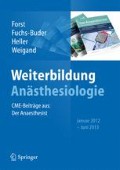Zusammenfassung
Der Einfluss des Alters auf die Organfunktionen beim geriatrischen Patienten wurde in Teil 1 dieses Beitrags (Anaesthesist 61:163–176) dargestellt. Der vorliegende Teil 2 beschäftigt sich mit dem Einfluss des Patientenalters auf Pharmakokinetik und Pharmakodynamik der Anästhetika sowie den daraus erwachsenden Konsequenzen für Anästhesieführung und postoperative Schmerztherapie. Stark vereinfachend ausgedrückt reagieren geriatrische Patienten häufig (viel) empfindlicher auf dieselbe Menge Anästhetikum, sodass im Alter eine Dosistitration erforderlich ist, nach Ansicht der Autoren am besten in Kombination mit einem Verfahren zur Messung der Narkosetiefe. Dabei werden die erforderlichen Dosierungen von Propofol sowie Remifentanil und auch die anschließenden Aufwach Zeiten mehr vom Alter als vom Gewicht der Patienten beeinflusst. Die Wirkdauer der meisten Muskelrelaxanzien ist verlängert, sodass eine Überwachung der neuromuskulären Funktion mithilfe der Relaxometrie empfohlen wird. Die postoperative Schmerztherapie sollte so geplant werden, dass möglichst wenig Opioide erforderlich sind oder ganz auf Opioide verzichtet werden kann.
Access this chapter
Tax calculation will be finalised at checkout
Purchases are for personal use only
Preview
Unable to display preview. Download preview PDF.
Literature
Antman EM, Benett JS, Daugherty A et al (2007) Use of nonsteroidal antiinflammatory drugs: an update for clinicians: a scientific Statement from the American Heart Association. Circulation 115:1634–1642
Arden JR, Holley FO, Stanski DR (1986) Increased sensitivity to etomidate in the elderly: initial distribution versus altered brain response. Anesthesiology 65:19–27
CopeTM, Hunter JM (2003) Selecting neuromuscular-blocking drugs for elderly patients. Drugs Aging 20:125–140
Eger El 2nd (2001) Age, minimum alveolar anesthetic concentration, and minimum alveolar anesthetic concentration-awake. Anesth Anaig 93:947–953
Eriksson LI, Sundman E, Olsson R et al (1997) Functional assessment of the pharynx at rest and during swallowing in partially paralyzed humans. Anesthesiology 87:1035–1043
Forrest JB, Camu F, Greer IA et al (2002) Ketorolac, diclofenac, and ketoprofen are equally safe for pain reliefafter major surgery. Br J Anaesth 88:227–233
FukudaT, KakiuchiY, Masayuki M et al (2003) Free lidocaine concentration during continuous epidural anesthesia in geriatric patients. Reg Anesth Pain Med 28:215–220
HerminghausA, Löser S, Wilhelm W (2012) Anästhesie bei geriatrischen Patienten. Teil 1: Alter, Organfunktion und typische Erkrankungen. Anaesthesist 61:163–176
HerminghausA, WachowiakM, Wilhelm W et al (2011) Intravenöses Lidocain zur perioperativen Schmerztherapie eine Übersicht und praktische Handlungsempfehlungen. Anaesthesist 60:152–160
Kazama T, Ikeda K, Morita K et al (1999) Comparison of the effect-site k(eO)s of propofol for blood pressure and EEG bispectral index in elderly and younger patients. Anesthesiology 90:1517–1527
Koscielniak-Nielsen ZJ, Bevan JC, Popovic V et al (1993) Onset of maximum neuromuscular block following succinylcholine or vecuronium in four age groups. Anesthesiology 79:229–234
Kreuer S, Biedler A, Larsen R et al (2003) Narcotrend monitoring allows faster emergence and a reduction of drug consumption in propofol-remifentanil anesthesia. Anesthesiology 99:34–41
Laufenberg-Feldmann R, Jage J (2011) Akutschmerztherapie in Pädiatrie und Geriatrie -Akutschmerztherapie im Alter ein ganzheitlicher Ansatz. Anasthesiol Intensivmed Notfallmed Schmerzther 46:354–364
MaplesonWW (1996) Effect of age on MAC in humans: a meta-analysis. BrJ Anaesth 76:179–185
Matteo RS, Ornstein E, Schwartz AE et al (1993) Pharmacokinetics and pharmacodynamics of rocuronium (Org 9426) in elderly surgical patients. Anesth Anaig 77:1193–1197
Minto CF, SchniderTW, Shafer SL (1997) Pharmacokinetics and pharmacodynamics of remifentanil. II. Model application. Anesthesiology 86:24–33
Ong CK, Lirk P, Tan CH, Seymour RA (2007) An evidence-based update on nonsteroidal anti-inflammatory drugs. Clin Med Res 5:19–34
Ott K (2010) Lipidlösungen zurTherapie der Lokalanästhetikaintoxikation. Anaesthesist 59:575–586
Paqueron X, Boccara G, Bendahou M et al (2002) Brachial plexus nerve block exhibits prolonged duration in the elderly. Anesthesiology 97: 1245–1249
Parker CJ, Hunter JM, Snowdon SL (1992) Effect of age, sexandanaesthetic technique on the pharmacokinetics of atracurium. BrJ Anaesth 69:439–443
Rivera R, Antognini JF (2009) Perioperative drug therapy in elderly patients. Anesthesiology 110:1176–1181
Schjerning Olsen AM, Fosbol, Lindhardsen J et al (2011) Duration of treatment with nonsteroidal antiinflammatory drugs and impact on risk of death and recurrent myocardial infarction in patients with prior myocardial infarction. Circulation 123:2226–2235
SchniderTW, Minto CF, Shafer SL et al (1999) The influence of age on propofol pharmacodynamics. Anesthesiology 90:1502–1516
Schüttler J, Ihmsen H (2000) Population pharmacokinetics of propofol. Anesthesiology 92:727–738
Scott JC, Stanski DR (1987) Decreased fentanyl and alfentanil dose requirements with age. A simultaneous pharmacokinetic and pharmacodynamic evaluation. J PharmacolExpTher 240:159–166
Silverstein JH, Rooke GA, Reves JG, McLeskey CH (2008) Geriatric anesthesiology. Springer Science & Business Media LLC
Stanski DR, Maitre PO (1990) Population pharmacokinetics and pharmacodynamics of thiopental: the effect of age revisited. Anesthesiology 72:412–422
Veering BT, Burm AGL, Vletter AA et al (1991) The effectof age on systemic absorption and systemic disposition of bupivacaine after subarachnoid administration. Anesthesiology 74:250–257
Veering BT, Burm AGL, Van Kleef JW etal (1987) Epidural anesthesia with bupivacaine: effects on age on neural blockade and pharmacokinetics. Anest Anaig 66:589–594
Wilhelm W, Wrobel M, Kreuer S, Larsen R (2003) Remifentanil eine Bestandsaufnahme. Anaesthesist 52:473–494
Wilhelm W, Kreuer S (2003) Das interpretierte EEG als Überwachungsverfahren in der Anästhesiologie. Anaesthesiol Intensivmed 44:8–15
Yu ZY, Wang W, Fritschy JM et al (2006) Changes in neocortical and hippocampal GABAA receptor subunit distribution during rain maturation and aging. Brain Res 1099:73–81
Zwissler B, Wappler F, Mertens E et al (2010) Präoperative Evaluation erwachsener Patienten vor elektiven, nichtkardiochirurgischen Eingriffen. Anaesthesist 59:1041–1050
Author information
Authors and Affiliations
Rights and permissions
Copyright information
© 2013 Springer-Verlag Berlin Heidelberg
About this chapter
Cite this chapter
Herminghaus, A., Löse, S., Wilhelm, W. (2013). Anästhesie bei geriatrischen Patienten. In: Weiterbildung Anästhesiologie. Springer, Berlin, Heidelberg. https://doi.org/10.1007/978-3-642-40715-4_3
Download citation
DOI: https://doi.org/10.1007/978-3-642-40715-4_3
Publisher Name: Springer, Berlin, Heidelberg
Print ISBN: 978-3-642-40714-7
Online ISBN: 978-3-642-40715-4
eBook Packages: Medicine (German Language)

